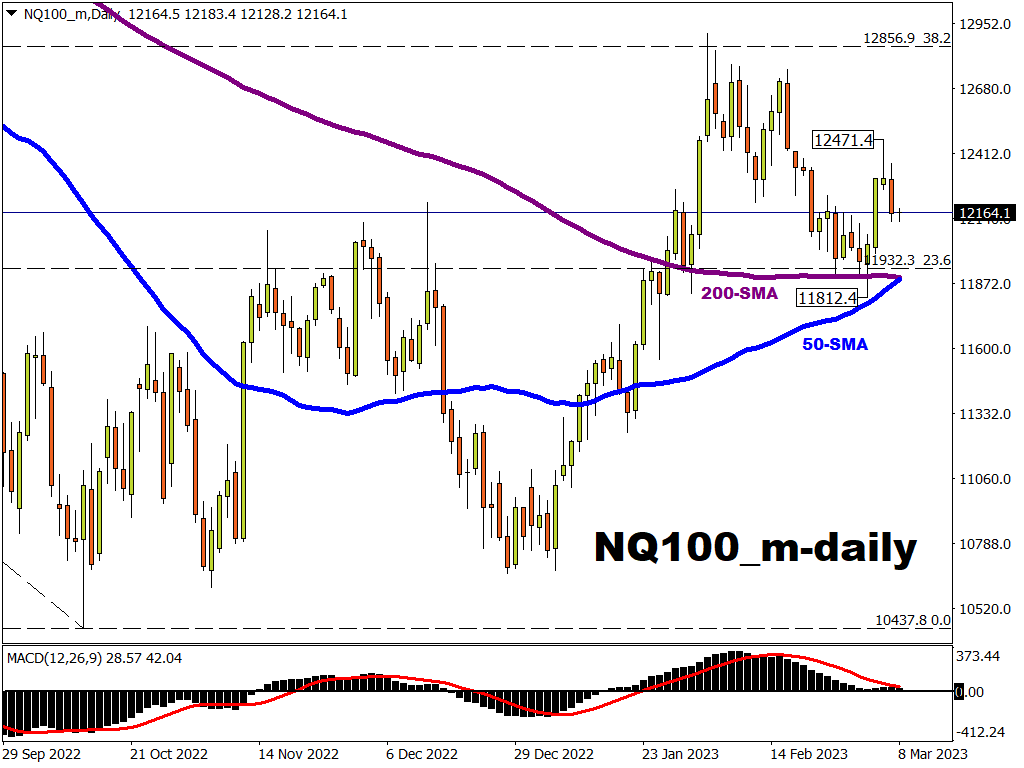But such a bullish technical signal may be well and truly lost amid the onslaught of macro events that are set to dictate how global financial markets fare the rest of this month.
What is a “golden cross”?
A golden cross is when the asset’s 50-day simple moving average (SMA) crosses above its 200-day SMA.
Such an event indicates that this asset’s prices have been climbing of late, enough to be higher than its longer-term average.
At the time of writing, the gap between those two widely-followed technical indicators now stand at less than 10 points on the NQ100m.
When it happens, the “golden cross” typically sends a “bullish” signal to traders, suggesting there could be more gains in store.

NOTE: The NQ100m is based on the benchmark Nasdaq 100 index, which tracks the overall performance of US tech stocks such as Apple, Amazon, and Alphabet.
How has NQ100m performed after forming a “golden cross” on the daily charts?
Here’s a look back at the previous two episodes:
-
22 May 2020: NQ100m went on to climb by 76.2% (after "golden cross") to post its highest-ever close on December 27, 2021 – the current record high.
- 2 April 2019: NQ100m rose by 29.6% on its way to a pre-pandemic high in February 2020, before lockdowns worldwide and the fear factor that coursed through global financial markets then sent the NQ100m plummeting below its 200-day SMA.
In both instances, after a “golden cross” on the daily charts, the NQ100m then duly surged to fresh record highs!
What’s next after a "golden cross"?
If such a bullish technical event does happen for the NQ100m, equity bulls (those hoping stocks will move higher) will be looking to eventually revisit this past Monday’s (March 6th, 2023) intraday high of 12471.4.
However, it’s different this time (or so goes the market cliché)!
After all, the Fed has been aggressively raising interest rates since 2022 in order to try and cool down inflation that’s raging at its highest levels since the 1980s.
The ongoing Fed rate hikes are in stark contrast to the:
-
April 2019 episode: prior Fed rate hikes coming into that year (2019) had resulted in US rates peaking at 2.5% (about half of today’s 4.75%) and the Fed would eventually start cutting interest rates later that year.
- May 2020: US interest rates were at a record low of near 0%, to help cushion the economic impact from Covid-19.
In essence, the Nasdaq 100 finds itself in a completely market environment from the ones in 2019 and 2020, despite the looming “golden cross”.
Recall that, tech stocks generally do not like the prospects of interest rates moving higher.
This is because:
-
Higher interest rates translate into higher repayments on loans.
-
And many tech companies rely on borrowed money to grow. And they've enjoyed plenty of cheap (near-zero interest rates) money over the past decade.
-
Hence, with more money now needed to repay borrowings, that’s less money that the company can use to grow its business, or to be kept as profits.
- Shareholders and investors would rather see those profits sooner rather than later. Hence, they are less willing to buy stocks in tech companies while US interest rates move higher.
Result = the Nasdaq 100 is still about 26% lower from its all-time high posted back in November 2021.
Hence, as stated at the top of this article, be mindful that any bullish technical signals emanating from any immediate “golden cross” may be lost amidst the incoming macro events.
What could move the NQ100m this month?
MARCH 10th: US nonfarm payrolls (NFP) report a.k.a. jobs data
MARCH 14th: US consumer price index (CPI) a.k.a. inflation data
MARCH 22nd: Fed rate decision
If markets are shown higher-than-expected readings for the US jobs/inflation data in the days ahead, and/or if the Fed triggers a larger-than-25 basis point hike later this month …
such cues could drag the Nasdaq 100 lower as market fears are revived that US interest rates will have to move higher past current forecasts.
In the above scenario, expect NQ100m bears (those hoping prices will fall) to test support around the 11,923 mark.
This is a significant support region, because:
-
That’s where we find the 23.6% Fibonacci level from its November 2021-October 2022 drop
- This is also around where the 200-day and 50-day SMAs are converging.
This confluence of technical indicators could form a strong support region for the NQ100m, barring an utter capitulation in risk sentiment.
Ultimately, global financial markets (including the NQ100m) are set to remain primarily driven by the shifting expectations surrounding how high the Fed will have to eventually send US interest rates.
Markets can only have greater confidence about the next bull run for the NQ100m once traders and investors can get used to the eventual peak for US interest rates, with hopes that the Fed can also start thinking about lowering rates once more.
Until then, the fear of even-higher US interest rates is likely to limit gains for the NQ100m.
READ MORE: (26 January 2023) SP500m close to forming “golden cross”. What’s next?
(After forming a "golden cross" the SP500m went on to hit all upside levels cited in the article.)